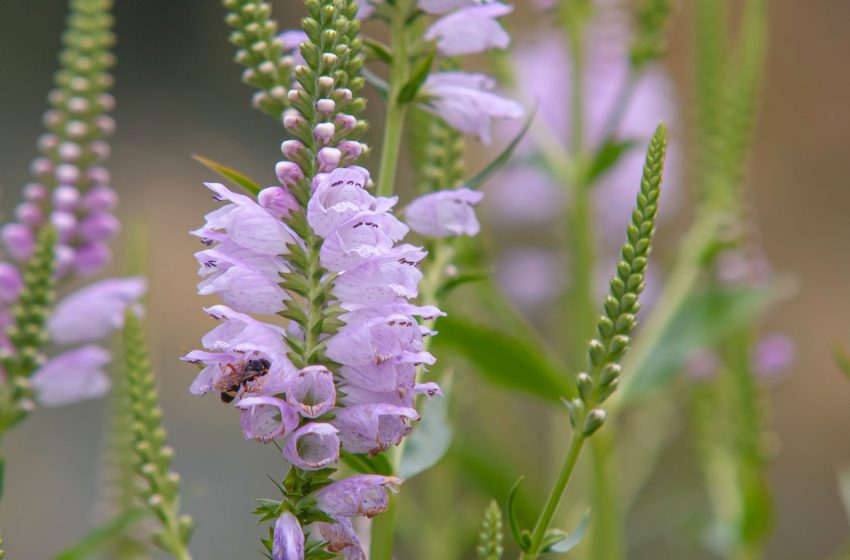magiccarouselsundays.com – The Obedient Plant (Physostegia virginiana) is a charming perennial known for its upright spikes of tubular flowers that are both striking and easy to grow. This plant’s unique name comes from its ability to “obey” when its flowers are gently repositioned, as they tend to stay in place, making it a fun and interactive addition to any garden. With its vibrant blooms and sturdy structure, the Obedient Plant is a favorite among gardeners who appreciate both beauty and resilience in their plants.
What is the Obedient Plant?
The Obedient Plant, also commonly known as False Dragonhead or Virginian Obedient Plant, is a perennial native to North America. It belongs to the mint family (Lamiaceae) and is characterized by its tall, narrow spikes of pink, purple, or white flowers that appear in late summer to fall. The plant grows to a height of 2 to 4 feet and forms dense clumps, making it an excellent choice for borders, wildflower gardens, or as a backdrop for shorter plants.
The plant’s common name, “Obedient Plant,” refers to the fact that its flowers can be gently moved or repositioned along the stem and will remain in place, making it an intriguing and interactive feature in the garden. This plant is hardy in USDA zones 3 through 9 and thrives in moist, well-drained soils.
Characteristics of Obedient Plant Flowers
Obedient Plant flowers are tubular and typically 1-2 inches long, blooming along the length of the upright stems. The flowers come in a variety of colors, including pink, lavender, white, and purple, depending on the cultivar. The blooms are arranged in dense clusters that create an eye-catching, spiky appearance, adding height and texture to the garden.
The flowers have a slight minty fragrance, attracting pollinators such as bees, butterflies, and hummingbirds, making the Obedient Plant an excellent choice for a wildlife-friendly garden. Its flowers also bloom sequentially from bottom to top, giving the plant a long-lasting display of color throughout the late summer and into the fall.
In addition to its flowers, the plant’s narrow, lance-shaped leaves are dark green and help create a lush backdrop to the vibrant blooms. The foliage is sturdy and helps the plant stand upright, even in windy conditions, which adds to its ornamental value in the landscape.
Growing Obedient Plant Flowers
Obedient Plants are relatively easy to grow and care for, making them a great addition to any garden. They thrive in a variety of conditions but perform best in areas with full sun to partial shade and moist, well-drained soil. The plant is tolerant of both drought and occasional flooding once established, although it prefers consistent moisture.
Here are some tips for growing Obedient Plants:
- Planting: Obedient Plants can be grown from seed, division, or nursery-bought plants. Start seeds indoors 6-8 weeks before the last frost date, or sow them directly in the garden once the weather warms up. Space the plants 12-18 inches apart to allow for proper air circulation and growth.
- Location: Choose a sunny or partially shaded spot with moist, well-drained soil. Obedient Plants do well in garden beds, along borders, or in a wildflower garden.
- Watering: Water the plant regularly, particularly during dry periods. While it can tolerate some drought, it thrives with consistent moisture and will produce the most blooms when kept well-watered.
- Fertilizing: Apply a balanced fertilizer in the spring to encourage strong growth and abundant flowers. Avoid over-fertilizing, as this can lead to excessive leaf growth at the expense of blooms.
- Pruning: Deadheading spent flowers can help encourage new blooms and maintain the plant’s appearance. In late fall, cut back the stems to the ground to prepare the plant for the winter months.
Symbolism and Cultural Significance
The Obedient Plant has a variety of symbolic meanings, many of which relate to its name. In the language of flowers, it is sometimes associated with obedience, humility, and flexibility due to the way its flowers respond to being moved. These symbolic meanings may have inspired the plant’s common name, as it seems to “obey” gardeners who reposition its flowers.
In addition to its symbolic significance, the Obedient Plant has been admired in garden design for centuries. Its easy-to-grow nature and vibrant blooms make it a favorite among both amateur and professional gardeners alike, and it has been cultivated for use in herbaceous borders and cottage gardens.
Ecological Benefits
Obedient Plants play a significant role in supporting local wildlife, particularly pollinators. The flowers attract bees, butterflies, and hummingbirds, which are essential for pollinating a variety of other plants in the garden. The plant’s sturdy stems and dense foliage also provide shelter for small insects and birds.
By growing Obedient Plants, gardeners can help promote biodiversity and contribute to the health of their local ecosystems. The plant is also beneficial in attracting beneficial insects, such as ladybugs, which can help manage pests in the garden.
Conclusion
The Obedient Plant is a striking and low-maintenance addition to any garden. With its spiky flowers, interactive nature, and ability to attract pollinators, it offers both beauty and functionality. Whether planted as a backdrop in flower beds or as a focal point in wildflower gardens, the Obedient Plant adds height, texture, and color to any landscape.
Its easy care and ability to thrive in a variety of conditions make it a favorite among gardeners, while its symbolic connection to obedience and humility adds a layer of depth to its appeal. Whether you’re looking to enhance your garden with vibrant blooms or provide a habitat for wildlife, the Obedient Plant is sure to delight.

